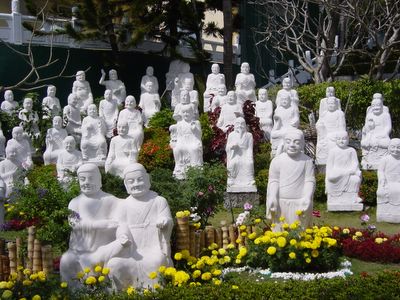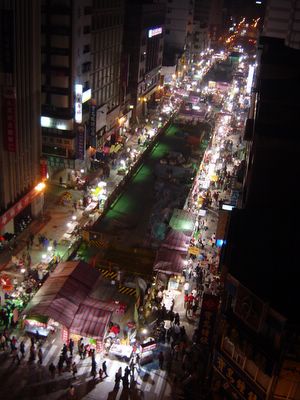I'm at a wireless cafe called c. coquette, at the corner of Marutamachi-dori and Teramachi, across the street from a walled corner of the Imperial Palace. It's awesome. It's nice and quiet and cozy. This is the first commercial establishment I've been in in Kyoto where I could relax after a day of finding my way around Kyoto and trodding about temples.
I came here to visit temples, but I think my being here is more like, "Practice? what practice?". I'm not saying I'm not "practicing", I think I am, just not actively, it's not foremost on my mind, but lingering in the background, waiting in the wings for more favorable conditions and fewer practical distractions, i.e., when I get back to Taiwan next Monday.
Today I've been to two eminent Zen temples, Daitoku-ji and Nanzen-ji, and the Zen aesteticized villa, Ginkakuji, cousin of the more famous Kinkakuji.
Someone else's tourist shot (for meghan), Ginkakuji:

I know I need to work on negativity and not being so criticizing, and in working on that, I should start by not saying anything at all, but I can't help creating fodder, showing my ignorance. So I'm going to say a few thoughts, aware that this is silly talk.
Visiting Buddhist temples, the first thing I notice is "where are the monks?". Also, why are there so many restricted areas? I walk into the temple grounds and I'm met with walls and gates that I'm not allowed through. Not very inviting. Where's the practice? But then I realize I'm wandering in at whatever random time of day, staying for 30-40 minutes, not knowing the language anyway. So I imagine the monks having gotten up at five in the morning when I was still asleep, doing morning sitting, eating, and cleaning and preparing the temple grounds for guests, all before I was even awake. By the time I got there, the monks were in their restricted areas of the temple, studying, copying sutras, cultivating arts, or whatever their practice entails. As if I have any idea what it is in a short, random visit, strolling in the front gates. I see barriers and rails where I can't go, feeling its always like that, but I imagine the monks putting them up as part of their morning work meditation, preparing for guests. Guests are a daily part of the temple's routine, so maybe they need to have restrictions and to sequester the monastics or they'd never get anything done.
As for Ginkakuji, I was thinking of the Zen aesthetic and asking what it had to do with Buddhism and practice? I thought of how Zen is just a technique, a tool to use, like learning how to hammer a nail. Buddhism requires going beyond that and using that skill to build a house, not just becoming expert at hammering nails. And that's what the Zen aesthetic seems like in Kyoto. Centuries and centuries of perfecting the art of hammering a nail into a plank of wood. Good job, it's not Buddhism. But who am I to say what is Buddhism, rogue that I am not even considering myself "Buddhist"? Of course if you read about the history of Buddhism in Japan and the constant struggle with politics, maybe I'm on slightly firmer ground. I think maybe the "Zen" aesthetic that developed in Kyoto had much to do with the Japanese aesthetic, and if it was Christianity that was brought in, a similar treatment would have been incorporated to make it more culturally palatable.
But the Kyoto Zen aesthetic for what it is, is pretty darned amazing.
Ginkakuji grounds, March 1, 2005, 11:14 A.M.






